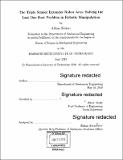The Triple Scissor Extender Robot Arm : solving the last one foot problem in robotic manipulation
Author(s)
Shikari, Abbas (Abbas M.)
DownloadFull printable version (2.788Mb)
Alternative title
Solving the last one foot problem in robotic manipulation
TSERA solving the last one foot problem in robotic manipulation
Other Contributors
Massachusetts Institute of Technology. Department of Mechanical Engineering.
Advisor
Harry Asada.
Terms of use
Metadata
Show full item recordAbstract
Final assembly, inspection, and maintenance of aircrafts, automobiles, and industrial equipment often requires a robot to reach confined areas that are difficult to access. While a robot can move freely in open space, the last one foot to a target site in a manufacturing environment is often cluttered with complex obstacles. Here we present a novel solution to the last one foot problem. Inspired by plant stem growth, a new design concept for an expandable arm, the Triple Scissor Extender Robot Arm (TSERA), is developed to access a confined area through a narrow channel. The robot consists of a series of expandable segments each of which is able to extend and tilt. Thus, the robot can elongate its structure along a narrow, winding space. The new design concept is accompanied by a new algorithm for path planning, the Sequential Expansion Algorithm. Unlike traditional algorithms for articulated robot path planning, TSERA's Sequential Expansion Algorithm reduces the otherwise computationally expensive multi body path planning problem to a single rigid body kinematics problem. Exploiting the serial nature of expandable structure, we can compute arm motion by sequentially solving a simple inverse kinematics problem for each segment.
Description
Thesis: S.M., Massachusetts Institute of Technology, Department of Mechanical Engineering, 2018. Cataloged from PDF version of thesis. Includes bibliographical references (pages 41-42).
Date issued
2018Department
Massachusetts Institute of Technology. Department of Mechanical EngineeringPublisher
Massachusetts Institute of Technology
Keywords
Mechanical Engineering.